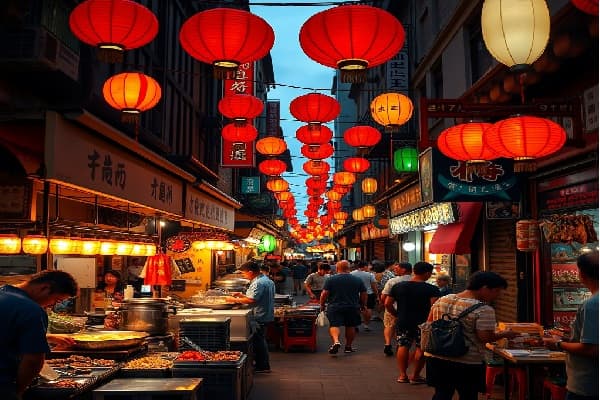Chinatown Hawker Leftovers Consumption: A Deep Dive into Culture, Sustainability, and Innovation

In cities like Singapore, Kuala Lumpur, and Bangkok, Chinatown hawker centers are bursting with energy and flavor. These open-air food courts are more than just places to eat—they’re cultural landmarks, gathering spots, and now, frontline heroes in a growing sustainability trend. A growing number of food lovers are embracing leftover consumption at Chinatown hawker stalls, and it’s a movement that’s changing the game.
This guide dives into the cultural roots of eating leftovers, the environmental benefits, the financial perks, and how you can get involved. Whether you love a good meal, care about the planet, or just want to stretch your dollar, there’s something here for you.
1. Why Leftovers Are Part of Chinatown’s Rich Food Culture
Eating leftovers isn’t a new idea in Chinatown—it’s steeped in history. In Chinese households, nothing goes to waste. Cooking creatively with extras or enjoying yesterday’s food for lunch is normal. That mindset naturally spills over to hawker centers.
By day’s end, many busy stalls have unsold but tasty food. Instead of tossing it, vendors often:
-
Offer discount plates or combo meals
-
Save extra portions for the next day
-
Donate to local charities
This isn’t just cost-saving—it’s honoring a culture that values respect for food and the hands that prepare it.
2. How Hawker Centers Tackle Food Waste (and Why It Matters)
Hawker centers are beloved for offering tasty meals on the cheap, but they’re also major food waste contributors. In Singapore, for example, hawker food accounts for around 20% of the city’s total food waste. That adds up fast.
Here’s why it matters:
-
Oversupply and big portions can overwhelm customers
-
Unsold dishes go to waste if not managed
-
Tossed food ends up in landfills, creating methane
Encouraging leftovers consumption helps by:
-
Reducing landfill-bound food
-
Saving water and energy used in cooking
-
Lowering greenhouse gas emissions
That’s not just good for vendors—it’s good for the planet.
3. Environmental Benefits: How One Plate Makes a Difference
Food waste is a major contributor to greenhouse gases worldwide—around 10% of emissions come from wasted food. When leftovers get eaten instead of thrown away, the impact is real:
-
Less waste in landfills, which release methane as they decompose
-
Fewer resources wasted, like water, energy, and fuel used in production
-
Reduced food production demands, easing climate strain
By embracing leftover culture, hawker centers become unlikely champions in the quest for greener cities.
`Also Read : That-Bites.org Foodies Corner: A Culinary Paradise for Every Food Lover
4. How Leftovers Support Vendors—and Why It’s a Win-Win
For hawker stall owners, leftovers aren’t just extra food—they’re an opportunity.
How leftover strategies help vendors:
-
Sell unsold portions at discounts, turning loss into profit
-
Create daily specials, attracting budget-conscious diners
-
Use refrigeration to store extras, reducing waste
With mobile apps and discount boards, restaurants can move more food and build goodwill—all while helping customers stretch their budgets.
5. Why Diners Love Leftover Deals
On the flip side, leftover-friendly hawkers offer something valuable to customers:
-
Affordable meals, ideal for students, seniors, and low-income workers
-
Nutritious options that don’t break the bank
-
Support for local businesses, boosting community ties
Leftovers redefine affordable dining by combining care for your wallet with mindful eating.
6. Singapore’s Chinatown Complex: A Sustainability Success Story
Singapore’s Chinatown Complex, home to over 260 hawker stalls, has become a hotspot for leftover initiatives:
-
End-of-day discount boards highlight leftover specials
-
Zero Waste campaigns raise awareness of food conservation
-
Food rescue volunteers collect unused meals for charity
-
Apps like OLIO and Treatsure offer live listings of leftover deals
At this vibrant hub, sustainability and convenience come together—benefiting vendors, shoppers, and the environment.
7. Addressing Safety Concerns Head-On
Worries about food safety can sometimes hold shoppers back from leftover meals—but Chinatown hawker centers follow strict hygiene rules:
-
Food is stored at proper temperatures
-
Clear labeling distinguishes fresh from reheated items
-
Time limits ensure only safe leftovers are sold
-
Inspections by health authorities are routine
Education campaigns reassure the public that leftovers, when handled properly, are just as safe as freshly made meals.
8. Shifting Perceptions: Turning Leftovers into a Badge of Sustainability
Eating leftovers is often stigmatized—but that’s changing. Thanks to champions like community leaders, influencers, and educators, leftover culture is being rebranded:
-
Campaigns highlight it as eco-conscious consumption
-
Incentives reward vendors and diners who take part
-
Celebrity chefs and public figures are promoting leftover specials
When eating leftovers is seen as a smart, planet-friendly choice—not a sign of financial stress—adoption grows naturally.
9. How Tech Is Boosting the Leftover Movement
In smart cities, tech is playing a big role:
-
OLIO, Treatsure, Yindii let sellers list leftover deals in real-time
-
QR feedback lets customers rate leftover dishes
-
AI inventory systems help vendors plan and minimize surplus
-
Blockchain tracking ensures transparency in food donations
Tech simplifies leftover transactions, reduces waste, and builds trust.
10. Community and NGOs: Powering the Movement from the Ground Up
Non-profit and grassroots players are driving the change too. In Chinatowns around the world, volunteers from universities, religious groups, and social clubs:
-
Collect leftovers for soup kitchens, shelters, and community dinners
-
Organize food rescue drives
-
Educate on nutrition and food waste
These efforts turn edible food into shared meals, reinforcing community bonds and nurturing care.
11. How Governments Can Help
Policy can turbocharge this momentum. Consider these supportive moves:
-
Tax breaks for vendors donating or discounting leftovers
-
Regulations requiring leftover labeling
-
Funding for public fridges or donation hubs
-
Public-private partnerships to build food-sharing apps
With smart policy design, leftover practices can become systemic—not just trendy.
12. A Global Movement with Chinatown Leading the Way
Cities worldwide are catching on. From Tokyo’s food basements to Taiwan’s night markets, people are rethinking leftover culture—and Chinatown sets the tone. With its deep food traditions, dense vendor networks, and strong community ties, the leftover movement in Chinatown feels authentic and ready to inspire others.
By positioning Chinatown as the leader, this movement can ripple outward—changing how we eat and share food globally.
Conclusion: Why Chinatown Hawker Leftovers Matter
What started as a cultural tradition is becoming a powerful sustainability trend. Leftover consumption in Chinatown hawker centers brings together culture, economy, community, and the environment.
It’s about:
-
Respecting tradition and food
-
Supporting small businesses
-
Feeding people affordably
-
Lowering waste and greenhouse gas emissions
-
Strengthening bonds between neighbors
Want to get involved? Here’s how:
-
Try leftovers specials next time you visit a hawker center
-
Download apps that list leftover deals
-
Share your experience on social media to normalize the movement
-
Support policies and businesses promoting sustainable eating
FAQ: Quick Answers on Leftover Culture
Is it safe to eat hawker leftovers?
Yes—so long as they’re stored properly and labeled correctly. Most hawker centers follow strict hygiene rules.
How do I find leftover deals in Chinatown?
Check apps like OLIO, Treatsure, or Yindii—or look for discount boards at the stall.
Why is this important for sustainability?
Every bit of food saved means less methane in landfills, lower resource use, and happier ecosystems.
Are there policies supporting leftovers in Singapore?
Yes—programs like the Zero Waste Masterplan encourage vendors and consumers to reduce waste, including by managing leftovers smartly.



